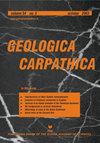Variscan缝合带的发掘历史:石炭-二叠系砂岩碎屑锆石年代学的约束西方喀尔巴阡山)
IF 1.5
4区 地球科学
Q4 GEOSCIENCES, MULTIDISCIPLINARY
引用次数: 5
摘要
在喀尔巴阡山脉西瓦里斯坎造山带的碰撞构造制度下,北格尔美勒统晚古生代沉积盆地在时间和空间上逐渐演化。从密西西比系、宾夕法尼亚系和二叠纪变质沉积物中获得的碎屑锆石年龄谱具有独特的年龄分布模式,反映了寄主沉积物的构造背景。密西西比系基底变质沉积层具有明显的单峰锆石分布,年龄峰值为352 Ma。这是沟-坡融合沉积盆地充填的遗迹。宾夕法尼亚期碎屑锆石种群表现出明显的多模态分布,主要年龄峰为351,450和565 Ma,较小的年龄峰为~2.0和~2.7 Ga。这与碰撞缝合带的碎屑岩向前陆盆地的演化一致。二叠纪沉积层锆石年龄也呈现多峰分布,主要峰位在300、355和475 Ma。与宾夕法尼亚碎屑锆石组合相比,主要区别在于零星出现Kasimovian - Asselian (306-294 Ma)和Artinskian-Kungurian (280-276 Ma)火成岩锆石。最年轻的岩浆锆石年龄与同沉积火山活动与二叠系寄主沉积的沉积年龄基本对应,清楚地指示了与伸展、裂谷有关的背景。本文章由计算机程序翻译,如有差异,请以英文原文为准。
Exhumation history of the Variscan suture: Constrains on the detrital zircon geochronology from Carboniferous–Permian sandstones (Northern Gemericum; Western Carpathians)
Abstract The Late Paleozoic sedimentary basins in the Northern Gemericum evolved gradually in time and space within the collisional tectonic regime of the Western Carpathian Variscan orogenic belt. The detrital zircon age spectra, obtained from the Mississippian, Pennsylvanian and Permian metasediments, have distinctive age distribution patterns that reflect the tectonic setting of the host sediments. An expressive unimodal zircon distribution, with an age peak at 352 Ma, is shown by the basal Mississippian metasediments. These represent a relic of the convergent trench-slope sedimentary basin fill. In comparison, the Pennsylvanian detrital zircon populations display distinct multimodal distributions, with the main age peaks at 351, 450, 565 Ma and smaller peaks at ~2.0 and ~2.7 Ga. This is consistent with derivation of clastic detritus from the collisional suture into the foreland basin. Similarly, the Permian sedimentary formations exhibit the multimodal distribution of zircon ages, with main peaks at 300, 355 and 475 Ma. The main difference, in comparison with the Pennsylvanian detrital zircon assemblages, is the sporadic occurrence of the Kasimovian– Asselian (306–294 Ma), as well as the Artinskian–Kungurian (280–276 Ma) igneous zircons. The youngest magmatic zircon ages nearly correspond to the syn-sedimentary volcanic activity with the depositional age of the Permian host sediments and clearly indicate the extensional, rift-related setting.
求助全文
通过发布文献求助,成功后即可免费获取论文全文。
去求助
来源期刊

Geologica Carpathica
地学-地球科学综合
CiteScore
2.40
自引率
23.10%
发文量
26
审稿时长
>12 weeks
期刊介绍:
GEOLOGICA CARPATHICA covers a wide spectrum of geological disciplines including geodynamics, tectonics and structural geology, volcanology, stratigraphy, geochronology and isotopic geology, karstology, geochemistry, mineralogy, petrology, lithology and sedimentology, paleogeography, paleoecology, paleobiology and paleontology, paleomagnetism, magnetostratigraphy and other branches of applied geophysics, economic and environmental geology, experimental and theoretical geoscientific studies. Geologica Carpathica , with its 60 year old tradition, presents high-quality research papers devoted to all aspects not only of the Alpine-Carpathian-Balkanian geoscience but also with adjacent regions originated from the Mediterranean Tethys and its continental foreland. Geologica Carpathica is an Official Journal of the Carpathian-Balkan Geological Association.
 求助内容:
求助内容: 应助结果提醒方式:
应助结果提醒方式:


